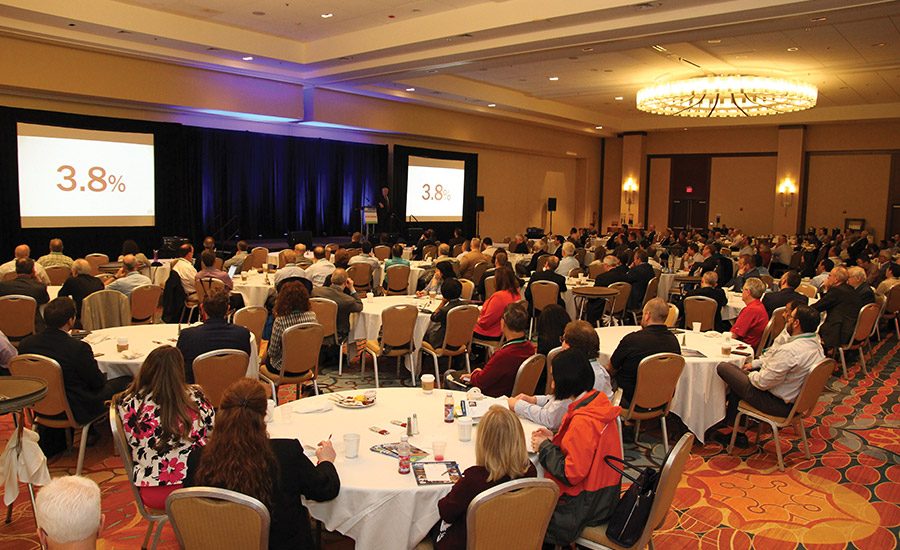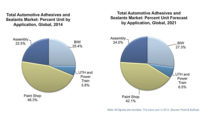The adhesives and sealants community gathered in Philadelphia April 8-10 for the Adhesive and Sealant Council’s (ASC) Annual Spring Conference and Expo. Attendees were able to broaden their knowledge during the keynotes and conference sessions, see the latest products and technologies on display during the exhibition, and network with peers in various settings over the dynamic three-day event.
Keynote Highlights
As ever, the ASC brought in keynote speakers who were able to share concepts and trends that are not only interesting, but will certainly prove useful to attendees as they assimilate the information into their business practices going forward. Tuesday morning’s breakfast keynote speaker was Matt Thornhill, founder and managing partner of SIR’s Institute for Tomorrow. Part of Thornhill’s discussion involved generational dynamics in the workplace, which can be a tricky balancing act. Surprisingly (at least to me), the number of Baby Boomers, Gen Xers and Millennials in the workforce is currently about the same.
While members of these different generations can sometimes approach their work differently, and it’s important to understand and acknowledge where others are coming from, the bottom line is fairly simple: people want to work in an environment where they feel they can be themselves. Companies that make their employees feel accepted and appreciated will have a leg up in today’s competitive workforce environment.
Thornhill also shared five trends for attendees to keep in mind as they consider what steps they can take to succeed in the future. The first trend involves workers—more specifically, the lack of them. With U.S. unemployment so consistently low, it’s quite difficult for organizations to find and retain qualified personnel. Thornhill suggests focusing on retention (you don’t need to replace employees if they stay), as well as developing proactive hiring practices. (Incidentally, if you have a few minutes, you might do well to visit a website he shared, www.willrobotstakemyjob.com. It provides an interesting snapshot of which occupations might suffer as a result of increasing automation.)
Another important trend, according to Thornhill, relates to work culture. He says that today’s work preferences include: “no dress code, no cubicles, work linked to a larger purpose, authentic connections with managers, learning and development opportunities, and fair promotion and advancement decisions.”
The last three trends that Thornhill shared involved some key end-use industries for adhesives and sealants: packaging, construction, and transportation. In packaging, Thornhill pointed out that older consumers (a growing demographic) want and need different packaging—particularly closures—than younger people. The construction industry is going to move to more modular builds, often utilizing 3D printing and sustainable materials. And in transportation, autonomous vehicles have the potential to change many aspects of our daily lives while providing multiple opportunities for adhesives and sealants. A video from Drive Sweden outlines some of the possibilities and can be found with this article on our website.
If you’re anything like me, your initial response to someone uttering the word “blockchain” might be a blank stare. Or perhaps you give the person a friendly smile as you try to work out why they’ve mashed together two seemingly unrelated words.
All kidding aside, before Wednesday morning’s breakfast keynote by Jack Shaw, co-founder and executive director of the American Blockchain Council, the blockchain concept was quite nebulous for many attendees, myself very much included. During his talk on “The Blockchain Transformation: How Blockchain Enabled Digital Transformation will Change Your Business, Your Industry, and the World,” Shaw provided not only an informative overview of blockchain, but specific instances where it will become transformative for future business practices.
Listening to a one-hour presentation isn’t going to make anyone an expert (again, myself very much included), but Shaw explained the concepts and possibilities such that attendees could develop an understanding and begin to think about how blockchain might factor into their businesses. To illustrate, he shared an example related to a sensitive airplane part. Today, a maintenance crew member would need to identify the part failure, and the airline would then go through the often complicated process of ordering a replacement part. The plane would be grounded while the part was ordered, shipped, received, and replaced—a lengthy and costly delay to the airline’s operation.
A blockchain-enabled procurement process would look quite different. Using automated artificial intelligence, a sensor in the plane could recognize that the part was going to need to be replaced soon—before it failed. The sensor would communicate with the plane’s maintenance system, which would in turn communicate with the airline’s procurement system. The automated procurement system would collect bids, select the best supplier, and have the part 3-D printed for almost immediate replacement. All of this could be happening while the plane remains in service, since the part itself is still working.
Blockchain can ensure the success of this time- and money-saving process by providing the ability to permanently and securely store and share data. A “chain” of computers in different locations all store records related to, in this example: the airline’s business; the plane’s complete specifications, including details related to the part that will soon need to be replaced; each of the potential suppliers’ businesses; and much more. All of this information is available with complete transparency to those who have been authorized to access it. Purchase orders and smart contracts can be initiated, facilitated, and managed through a secure, common data pool beginning with the manufacturer all the way through the supply chain.
According to Shaw, security is ensured because access is limited and the chain is synchronized. This means that the nodes in the chain (i.e., each of the computers) would recognize if something in one node had been altered without authorization and would change protocols to protect the data and isolate that node.
Blockchain is fascinating stuff, and it has far-reaching ramifications for business and our personal lives as well. Shaw encouraged attendees to learn
more about blockchain and incorporate that information while building a digital transformation strategy for their businesses.
Conference Sessions
The conference was organized into multiple tracks, including: Business Development and Market Trends; Technical and Government Regulations; and New Technology and Application. I had the opportunity to attend many of the conference sessions, and the range of development and innovation was exciting to see. A smattering of these speakers and topics included:
- Matt Tjosaas, NatureWorks Applications Development chemist, “Lactide Polyester Resins as Solvent-Borne Adhesives in 3-D Applications”
- Christian Lenges, Biomaterials business development with DuPont Industrial Biosciences, “Engineered Polysaccharides: Alpha-1,3-Glucan Polymer as a Performance Enhancing Additive for Latex Adhesives”
- Ruel McKenzie, assistant professor at the University of Akron, “Anomalous Crystal Growth in an Epoxy-Ionic Liquid System”
- Mammad Nasiri, senior research chemist with Henkel Corp., “Functional Polymers Derived from Biomass: Development, Study, and Performance Enhancement”
- Gregory Hall, ExxonMobil Chemical Co. senior staff scientist, “Climbing the Summits of HMAs in Assembly Applications”
- Chris Orilall, R&D manager for Sartomer Americas, “An Electron Beam Curable Resealable Adhesive that Only Sticks to Itself”
- Daniel Mania, development chemist with Wacker Chemical Corp., “Frozen and Wet Lumber Bonding Using Silane Modified Polymers (SMP) via DOE”
- Sheba Bergman, Evonik Corp.’s Applied Technology manager for NAFTA Functional Silanes, “Advances Toward Non-Yellowing Optically Clear SMP Based Formulations”
- Misty Huang, principle scientist for Momentive Performance Materials, “New Silane Oligomers—Improve Adhesion and Beyond”
- Bob Schieble, Enercon regional Sales manager, “New Blown-ion™ Plasma Treaters for Improving Adhesion”
- Peter Kuzyk, business manager for Nordson EFD Fluid Formulators & Packagers, “Advantages of Sustainable, Collapsible Film-Based Technology for Two-Component (2K) Fluid Packaging”
- Davide De Santi, Versalis SPA R&D, “Styrenic Block Copolymers in Hot-Melt Adhesives: A Comparison between Sequential and Via-Coupling Polymer Structure for the Optimization of Hot-Melt Performances in Non-Woven Applications”
- Otto Soidinsalo, Technical Application manager for Borregaard, “Improved Rheological Profile and Stability for Waterborne Polychloroprene Dispersion Adhesives”
- Tom Vetterly, Mayzo’s director of Technology, “A Practical Approach to Common Problems with Processing Additives in Adhesives”
In all, the conference featured around 50 different presentations. Look for further details on many of these topics in future issues of ASI.
See You Next Year!
This year’s event also included short courses, ASC member meetings, awards presentations, scholarship announcements, a multitude of networking opportunities, and more. It was wonderful to see the industry coming together once again to build a stronger future.
This spirit of enrichment will surely only grow as the ASC organizes next year’s World Adhesive & Sealant Conference in Chicago. Registration and additional details are available at https://wac2020.org.
For additional information, visit www.ascouncil.org.






